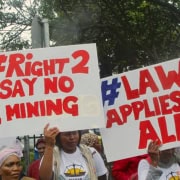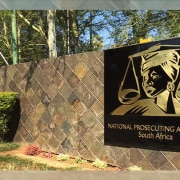|
Getting your Trinity Audio player ready...
|
In part two of our new two-part mini-series on gold laundering, we look back into South Africa’s gold mining history and the role which gold laundering played in financing the apartheid government’s attempts to cling to power. Part one set the scene as it is today, and looked at possible measures to address the growing problem.
South Africa’s gold mining history is particularly shameful. Because gold deposits were buried deep underground, investment in underground operations to mine the reefs was necessary from the start. The diamond tycoons – the randlords, mostly of European or British origin – who were already plundering the country’s gemstone resources quickly took advantage and control of the burgeoning gold industry. They were led by industrialists such as Cecil John Rhodes, Nathaniel Rothschild, and later, Ernest Oppenheimer.
Of necessity, a large workforce had to be recruited. “The South African gold mining industry in 1980 alone employed 472 000 workers, 44 000 of whom were white and 428 000 black,” notes Prof Mark Pieth, president of the Basel Institute on Governance, in his book Gold Laundering: The dirty secrets of the gold trade. With the government’s help, through a series of dastardly laws and taxes, the randlords dispossessed the non-white population of South Africa of their rights to land, intending to drive them to the cities and hence the mines. This policy was later extended to include workers from the larger Southern African region.
In 1913, the infamous Native Land Act took away black South Africans’ right and ability to farm, leaving them no choice but to seek a living elsewhere. The hostels in which the labourers lived were, and remain today, a hotbed of unrest and instability.
By 1969, says Pieth, “the discrepancy between the miners’ salaries and the profits of the mine owners could not have been greater.”
South Africa’s gold industry, built on the hard labour of hundreds of thousands of people, grew to become the world’s most productive. In the 1980s, South Africa produced 50% of the world’s gold. It remained the top producer globally until 2007, when China overtook it.
But the injustices persist, to this day. In 2012, miners at Marikana in the North West province, where Lonmin was mining platinum, went on an unauthorised strike for better pay and living conditions. Several people were killed in violence leasing up to the fatal day, 16 August 2012, where police opened fire on a group of miners camping on a nearby hilltop. Thirty-four people lost their lives on that day – none of them police – and a commission of inquiry absolved political figures involved of any culpability.
“For too long mining giants have been getting away with pollution, forced evictions, lack of transparency over how mining rights are awarded, corruption, tax evasion and abusive transfer pricing,” said Deprose Muchena, a senior director in Amnesty International’s South African office, in an article on the organisation’s website, published ahead of the 2020 Mining Indaba in Cape Town.
“Mining bosses have prioritised profit at the expense of human rights and the environment.”
Paying for gold with human rights crimes
Gold has been inextricably linked with human rights crimes since it was first discovered in South Africa in 1886. We have already briefly discussed how the mining industry was built on the toil and exploitation of a large workforce which was to a large degree manipulated into doing the back-breaking work.
In the late 1880s the influx of gold-hungry prospectors, many of them foreign, exacerbated political tensions in the areas where gold was found. This eventually led to the Second Boer War of 1899, in which nearly 100 000 men, women, and children lost their lives. Another fatal consequence of the war was the rise of Afrikaner nationalism that underpinned apartheid, leading to the deaths of hundreds more.
The shameful apartheid era was itself fuelled by gold, especially after countries opposing the segregationist policies of the day began to impose sanctions, mostly involving trade and finance, against South Africa. “The South African apartheid regime could only survive against the growing international protest and boycott movement by trading its gold. It was therefore crucial to find a reliable trading partner,” Pieth says.
Established in November 1961, the London Gold Pool was a conduit for South Africa to sell its gold on the London gold market, through the Bank of England. When this structure collapsed in 1968, causing the closure of the London bullion market as well as uncertainty and instability in the trade, three major Swiss banks – Credit Suisse, the Union Bank of Switzerland, and the Swiss Bank Corporation – set up a gold trading arrangement known as the Zürich Gold Pool.
This was good news for the apartheid government. “What has been referred to as the ‘South African coup’,” says Pieth, “involved these banks convincing South Africa to market its production through Zurich. The Zurich bankers also managed to attract Soviet gold.”
In the 1980s, he adds, Switzerland played a key role for South Africa. “In addition to arms exports, it marketed the internationally isolated country’s gold and diamonds. In 1985-6, Swiss bankers led by the former chairman of the Swiss National Bank Fritz Leutwiler even engaged in restructuring South Africa’s public debt, preventing its bankruptcy.”
Pieth is critical of this role, saying that by refusing to implement international sanctions, Switzerland replayed the “behaviour shown as bankers of the Nazis”.
Despite claims that it had expressed its public disagreement with the policies of the apartheid government, Switzerland continued to covertly assist it, eventually marketing between 60% and 80% of South Africa’s gold production in the 1980s.
“According to the Swiss government’s National Research Program 42+ on Relations between Switzerland and South Africa, close to 80% of the gold imported from South Africa during the 1980s was re-melted and stamped with a Swiss quality seal by Swiss refiners.”
This amounts to gold laundering, says Pieth, and the Swiss government probably co-operated in the scheme, going as far to withhold official trade statistics on gold between 1981 and 2014, and to block access to relevant archives. “Even researchers have been denied access to archives relating to Swiss connections to South African apartheid for fear of legal action.”
The Rand Refinery
South Africa’s Rand Refinery, located in Germiston, east of Johannesburg on the East Rand and one of the most famous such operations in the world, is now 102 years old. It was registered as a private company in 2910, “with initial capital raised from shares limited to gold mining companies that were members of the Chamber of Mines”, according to the refinery.
Rand is said to have refined about 30% of all the gold that has ever been pulled from the ground, and during the apartheid years, this was where the regime of the day refined its gold. It supplied the South African Mint with the materials to produce Krugerrands, which it then marketed overseas during the boycott years, and beyond – it still does today. It also refined gold from the DRC before the genocide was exposed, says Pieth.
However, the refinery has since raised its game and now participates in all major due diligence efforts, he adds. This is particularly important because in recent years the refinery has accepted gold from other African countries, to the extent that 75% of all gold mined in Africa now comes to the Rand Refinery. Although the risk exposure of the refinery itself is ambiguous, this new development may necessitate increased due diligence.








